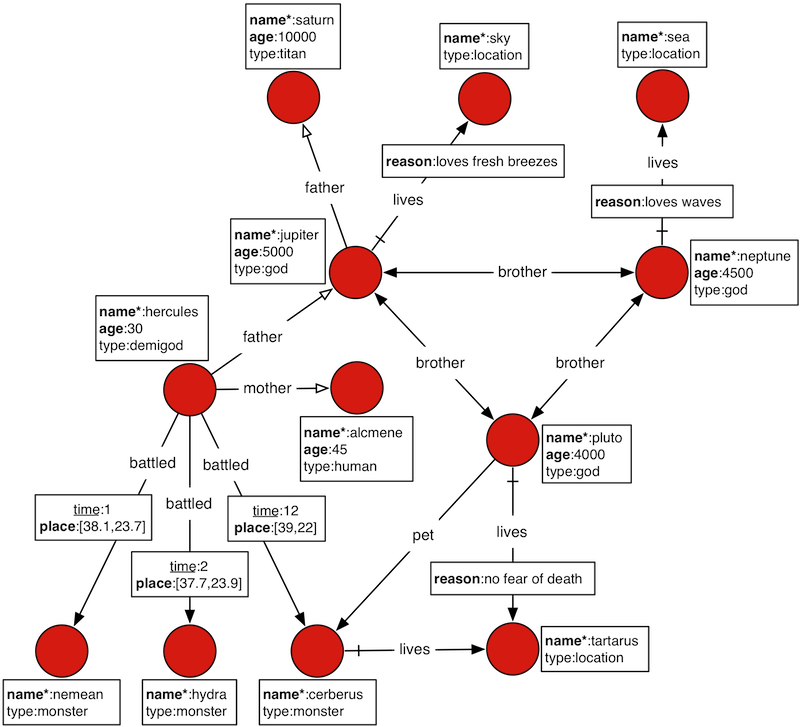JanusGraph
In this tutorial, you are first going to setup JanusGraph to work with YugabyteDB as the underlying database. Then, using the Gremlin console, you are going to load some data and run some graph commands.
1. Start local cluster
Start a cluster on your local machine. Check that you are able to connect to YugabyteDB using ycqlsh by doing the following.
$ ycqlsh
Connected to local cluster at 127.0.0.1:9042.
[ycqlsh 5.0.1 | Cassandra 3.9-SNAPSHOT | CQL spec 3.4.2 | Native protocol v4]
Use HELP for help.
ycqlsh> DESCRIBE KEYSPACES;
system_schema system_auth system
ycqlsh>
2. Download JanusGraph
Download from the JanusGraph downloads page. This tutorial uses the 0.2.0 version of JanusGraph.
$ wget https://github.com/JanusGraph/janusgraph/releases/download/v0.2.0/janusgraph-0.2.0-hadoop2.zip
$ unzip janusgraph-0.2.0-hadoop2.zip
$ cd janusgraph-0.2.0-hadoop2
3. Run JanusGraph with YugabyteDB
- Start the Gremlin console by running
./bin/gremlin.sh. You should see something like the following.
$ ./bin/gremlin.sh
\,,,/
(o o)
-----oOOo-(3)-oOOo-----
plugin activated: janusgraph.imports
plugin activated: tinkerpop.server
plugin activated: tinkerpop.utilities
plugin activated: tinkerpop.hadoop
plugin activated: tinkerpop.spark
plugin activated: tinkerpop.tinkergraph
gremlin>
- Now use the YCQL config to initialize JanusGraph to talk to Yugabyte.
gremlin> graph = JanusGraphFactory.open('conf/janusgraph-cql.properties')
==>standardjanusgraph[cql:[127.0.0.1]]
- Open the YugabyteDB UI to verify that the
janusgraphkeyspace and the necessary tables were created by opening the following URL in a web browser:http://localhost:7000/(replacelocalhostwith the IP address of any master node in a remote deployment). You should see the following.

4. Load sample data
We are going to load the sample data that JanusGraph ships with - the Graph of the Gods. You can do this by running the following:
gremlin> GraphOfTheGodsFactory.loadWithoutMixedIndex(graph,true)
==>null
gremlin> g = graph.traversal()
==>graphtraversalsource[standardjanusgraph[cql:[127.0.0.1]], standard]
5. Graph traversal examples
For reference, here is the graph data loaded by the Graph of the Gods. You can find a lot more useful information about this in the JanusGraph getting started page.

- Retrieve the Saturn vertex
gremlin> saturn = g.V().has('name', 'saturn').next()
==>v[4168]
- Who is Saturn’s grandchild?
gremlin> g.V(saturn).in('father').in('father').values('name')
==>hercules
- Queries about Hercules
gremlin> hercules = g.V(saturn).repeat(__.in('father')).times(2).next()
==>v[4120]
// Who were the parents of Hercules?
gremlin> g.V(hercules).out('father', 'mother').values('name')
==>jupiter
==>alcmene
// Were the parents of Hercules gods or humans?
gremlin> g.V(hercules).out('father', 'mother').label()
==>god
==>human
// Who did Hercules battle?
gremlin> g.V(hercules).out('battled').valueMap()
==>[name:[hydra]]
==>[name:[nemean]]
==>[name:[cerberus]]
// Who did Hercules battle after time 1?
gremlin> g.V(hercules).outE('battled').has('time', gt(1)).inV().values('name')
==>cerberus
==>hydra
6. Complex graph traversal examples
- Who are Pluto's cohabitants?
gremlin> pluto = g.V().has('name', 'pluto').next()
==>v[8416]
// who are pluto's cohabitants?
gremlin> g.V(pluto).out('lives').in('lives').values('name')
==>pluto
==>cerberus
// pluto can't be his own cohabitant
gremlin> g.V(pluto).out('lives').in('lives').where(is(neq(pluto))).values('name')
==>cerberus
gremlin> g.V(pluto).as('x').out('lives').in('lives').where(neq('x')).values('name')
==>cerberus
- Queries about Pluto’s Brothers.
// where do pluto's brothers live?
gremlin> g.V(pluto).out('brother').out('lives').values('name')
==>sea
==>sky
// which brother lives in which place?
gremlin> g.V(pluto).out('brother').as('god').out('lives').as('place').select('god', 'place')
==>[god:v[4248],place:v[4320]]
==>[god:v[8240],place:v[4144]]
// what is the name of the brother and the name of the place?
gremlin> g.V(pluto).out('brother').as('god').out('lives').as('place').select('god', 'place').by('name')
==>[god:neptune,place:sea]
==>[god:jupiter,place:sky]
7. Global graph index examples
Geo-spatial indexes - events that have happened within 50 kilometers of Athens (latitude:37.97 and long:23.72).
// Show all events that happened within 50 kilometers of Athens (latitude:37.97 and long:23.72).
gremlin> g.E().has('place', geoWithin(Geoshape.circle(37.97, 23.72, 50)))
==>e[4cj-36g-7x1-6c8][4120-battled->8216]
==>e[3yb-36g-7x1-9io][4120-battled->12336]
// For these events that happened within 50 kilometers of Athens, show who battled whom.
gremlin> g.E().has('place', geoWithin(Geoshape.circle(37.97, 23.72, 50))).as('source').inV().as('god2').select('source').outV().as('god1').select('god1', 'god2').by('name')
==>[god1:hercules,god2:hydra]
==>[god1:hercules,god2:nemean]